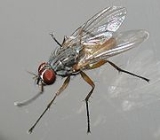
Lesser house fly
Encyclopedia
The lesser house fly or little house fly, Fannia canicularis, is somewhat smaller (3.5 millimetre) than the common housefly
. It is slender, and the median vein in the wing is straight. Larvae
feed on all manner of decaying organic matter, including carrion
. It is the most common vector of myiasis
within the Fanniidae
.
. In females the eyes do not meet together. The brown-grey thorax has three black longitudinal stripes in the males.These are much more indistinct in the female. The first two segments of the abdomen are translucently yellow with a dark-brown basal colour. The dark trapezoid marks of the males are hardly recognizable in the females. The halteres
are yellowish.
approximately seven generations can develop per year. They are often found on excrement and on vertebrate animal. Because of their oscillating between excrement and human food the species is considered as possible disease carriers. From May to Octobers the small housefly comes frequently into buildings and is noticeable here by its peculiar, silent flight in the room center, where it circles down-hanging articles, particularly lamps. It changes the flight direction jerkily. This is a patrol flight, in which the males supervise if necessary their district and intruders attack. During short breaks and in the night hours the flies sit at lamps or on walls and leave there small excrement marks. In the wild tree branches serve the flies for their swarm dances.
Housefly
The housefly , Musca domestica, is a fly of the suborder Cyclorrhapha...
. It is slender, and the median vein in the wing is straight. Larvae
Larva
A larva is a distinct juvenile form many animals undergo before metamorphosis into adults. Animals with indirect development such as insects, amphibians, or cnidarians typically have a larval phase of their life cycle...
feed on all manner of decaying organic matter, including carrion
Carrion
Carrion refers to the carcass of a dead animal. Carrion is an important food source for large carnivores and omnivores in most ecosystems. Examples of carrion-eaters include vultures, hawks, eagles, hyenas, Virginia Opossum, Tasmanian Devils, coyotes, Komodo dragons, and burying beetles...
. It is the most common vector of myiasis
Myiasis
Myiasis is a general term for infection by parasitic fly larvae feeding on the host's necrotic or living tissue. Colloquialisms for myiasis include flystrike, blowfly strike, and fly-blown. In Greek, "myia" means fly....
within the Fanniidae
Fanniidae
The Fanniidae are a small group of true flies largely confined to the Holarctic and temperate Neotropical regions.There are 11 Afrotropical species, 29 Oriental, and 14 Australasian. See Biogeographic Regions....
.
Morphology
Fannia canicularis is a slim fly reaching a length of from four to six millimetres. The white-bordered eyes meet above in the male a condition described as holopticHoloptic
Holoptic refers to the way the eyes of a dipteran meet along the dorsal length of its head. Holoptic eyes are typical of several diptera males, in particular the Syrphoidea ....
. In females the eyes do not meet together. The brown-grey thorax has three black longitudinal stripes in the males.These are much more indistinct in the female. The first two segments of the abdomen are translucently yellow with a dark-brown basal colour. The dark trapezoid marks of the males are hardly recognizable in the females. The halteres
Halteres
Halteres are small knobbed structures modified from the hind wings in some two-winged insects. They are flapped rapidly and function as gyroscopes, informing the insect about rotation of the body during flight....
are yellowish.
Development
The females lay their eggs in in batches of up to 50 and may lay altogether up to 2,000 eggs. The eggs, which are white with a pair of dorsal longitudinal flanges or wings, and have the ability to float in liquid and semi-liquid decaying organic matter, especially poultry, cow and dog feces, kitchen wastes as the end of putrid potatoes or carrots, silage and compost, in addition, cheese, bacon and drying fish. They are commonly found in garbage depots, wheelie bins, garbage trucks and other places where food waste is stored. The eggs hatch after only 2 days (24 to 48 hours at 24–27 °C or 75.2–80.6 F) and the larvae require 6 or more days to reach pupation, which lasts 7 or more days so that they usually take approx. 2–4 weeks to develop into adults, depending upon temperature repeating the live cycle again in very damp, putrid excrement, liquid manure, etc.Behaviour
Fannia canicularis is spread world-wide and has a life expectancy from two to three weeks. In Central EuropeCentral Europe
Central Europe or alternatively Middle Europe is a region of the European continent lying between the variously defined areas of Eastern and Western Europe...
approximately seven generations can develop per year. They are often found on excrement and on vertebrate animal. Because of their oscillating between excrement and human food the species is considered as possible disease carriers. From May to Octobers the small housefly comes frequently into buildings and is noticeable here by its peculiar, silent flight in the room center, where it circles down-hanging articles, particularly lamps. It changes the flight direction jerkily. This is a patrol flight, in which the males supervise if necessary their district and intruders attack. During short breaks and in the night hours the flies sit at lamps or on walls and leave there small excrement marks. In the wild tree branches serve the flies for their swarm dances.

